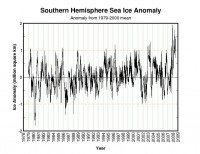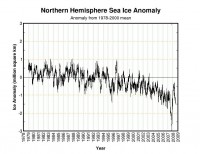By Joseph D’Aleo, CCM, Fellow, AMS
In another in an endless series of half the story articles, Livescience staff reported on the further fracturing of the Wilkins Ice sheet. “A vast shelf of ice in Antarctica is hanging on to the continent by a thread and is not expected to survive, scientists announced today. The entire Wilkins shelf, before the recent breakups, covered about 6,180 square miles (16,000 square kilometers - about the size of Northern Ireland).” (It should be noted the current total Antarctic ice extent is 13,000,000 square kilometers making Wilkins merely 0.1% of the total) and the ice is at a record extent for this time of year and appears headed to challenge or exceed last year’s record. It is mid-winter there now with 2 months more of ice growth.

See larger image
“Wilkins Ice Shelf is the most recent in a long, and growing, list of ice shelves on the Antarctic Peninsula that are responding to the rapid warming that has occurred in this area over the last fifty years,” said David Vaughan of the British Antarctic Survey. “Current events are showing that we were being too conservative when we made the prediction in the early 1990s that Wilkins Ice Shelf would be lost within thirty years - the truth is it is going more quickly than we guessed.” This latest stage of the breakup occurred during the Southern Hemisphere’s winter, when atmospheric temperatures are at their lowest. One idea is that warmer water from the Southern Ocean is reaching the underside of the ice shelf and thinning it rapidly from underneath.
Richard Courtney, an expert peer reviewer for the Intergovernmental Panel on Climate Change who in November 1997 chaired the Plenary Session of the Climate Conference in Bonn responded “The suggested “idea” really is clutching at straws. Melting is induced by heat and fracture is induced by stress. The fractures are happening in winter. And winter is the season when temperatures are at their lowest and when ice growth is greatest. Unless there is direct evidence of the ice thinning then there is no reason to introduce any suggestion that the fracture of the ice bridge is related to higher temperatures. Indeed, the fact that the fractures are happening in the winter implies that the reverse is true: i.e. the most probable explanation is that large ice growth is providing stress to the ice bridge with resulting stress fractures of the bridge.”
By the way, UAH MSU showed among the past 30 Junes, June 2008 was the third coldest south of the Antarctic Circle. The Antarctic continent saw its third coldest June in 30 years, with temperatures averaging -1.53C cooler than the seasonal norm. Portions of Anarctica south of Australia were as much as 5.5 C (9.9 degrees Fahrenheit) colder than seasonal norms for the first month of winter. The low yesterday at the South Pole Amundsen Scott AFB was -95F.
Meanwhile at the top of the world, Livesecience repeated earlier claims that melting has become so rapid that scientists say the North Pole could be ice-free this summer.

See larger image
See how the arctic is are running 1 million square kilometers ahead of last year above. Follow it daily on the University of Illinois Cryosphere here. See how the University of Colorado NSIDC which projected a 50/50 chance of full ice melt this summer shows the ice tracking this years versus last here. You will see we so far have been seeing a slower melt with a move away from the 2007 extent towards normal.




